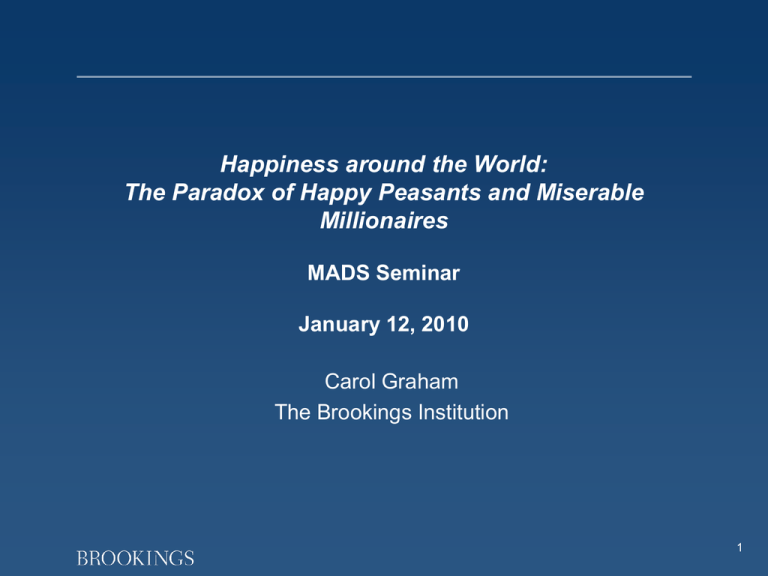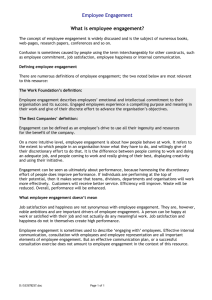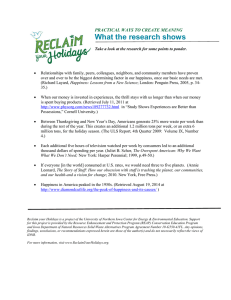Happiness around the World: The Paradox of Happy Peasants and Miserable Millionaires
advertisement

Happiness around the World: The Paradox of Happy Peasants and Miserable Millionaires MADS Seminar January 12, 2010 Carol Graham The Brookings Institution 1 Happiness around the world: A story of adaptation to prosperity and adversity • • • • • • • Presentation is based on my studies of happiness around the world (and on new OUP book, Happiness around the World: Happy Peasants and Miserable Millionaires) Focuses on question of how some individuals who are destitute report to be happy, while others who are very wealthy are miserable, and on the role of norms and adaptation in explaining the conundrum Adaptation is the subject of much economics work, but definition is psychological: adaptations are defense mechanisms; there are bad ones like paranoia; healthy ones like humor, anticipation, and sublimation Set point theory: people can adapt to anything - bad health, divorce, poverty, high levels of crime and corruption - and return to a natural level of cheerfulness My studies suggest people are remarkably adaptable; people in Afghanistan are as happy as Latin Americans and 20% more likely to smile in a day than are Cubans; Kenyans are as satisfied with their health care as Americans are How can this not be a good thing? May be from an individual perspective, but may also allow for collective tolerance for bad equilibrium Examples from economics, democracy, crime and corruption, and health 2 Why Happiness Economics? • • • • New method combining tools and methods of economists with those typically used by psychologists Method captures broader elements of welfare than do income data alone Method is uniquely well-suited for analyzing questions where revealed preferences do not provide answers, for example the welfare effects of institutional arrangements individuals are powerless to change (like inequality or macroeconomic volatility) and/or behaviors that are driven by norms or by addiction and self control problems (alcohol and drug abuse, smoking, obesity) While economists traditionally have shied away from reliance on surveys (e.g. what people say rather than what they do), there is increasing use of data on reported well-being (happiness): a) Consistent patterns in the determinants of well being across large N samples across countries and across time b) Econometric innovations help account for error and bias in survey data (AND with the error that exists in all kinds of data!!) 3 Why NOT Use Happiness Surveys • • • Biases in the way people answer surveys (question ordering/random events) Adaptation – at individual and country levels » Individual level: some psychologists believe that people ALWAYS adapt to their set point, even after extreme events like divorce or spinal cord injuries; THUS if a poor peasant, who has adapted to his/her condition and/or has low aspirations due to lack of information reports he/she is happy, how is this information relevant to policy? (happy peasant versus frustrated achiever problem) » Country level: Easterlin paradox - average happiness levels have not increased over time as rich countries get richer and make improvements in other areas such as health, education; New findings based on Gallup Poll – challenge paradox and find clear happiness/GDP per capita link – BUT problems with findings: a) question framing b) new data over-represents small poor countries in SSA with falling GNP per cap and the transition economies; so findings may be driven by falling income effects, not rising ones as in Easterlin paradox; ONGOING debate 4 Happiness and Income Per Capita, 1990s 100 % above neutral on life satisfaction NETHERLANDS CANADA 90 SWITZERLAND IRELAND 80 SWEDEN U.S.A. NEW ZEALAND NIGERIA PORTUGAL CHINA JAPAN 70 FRANCE INDIA BANGLADESH 60 BRAZIL VENEZUELA PANAMA ROMANIA MEXICO S.AFRICA 50 HONDURAS HUNGARY GUATEMALA COLOMBIA URUGUAY 40 CHILE EL SALVADOR COSTA RICA NICARAGUA 30 ARGENTINA BULGARIA PARAGUAY 20 BOLIVIA RUSSIA R ECUADOR 2 =0.14 PERU 10 0 2,000 Sour ce: Gr ahamand Pettinato, 2002. 4,000 6,000 8,000 10,000 12,000 14,000 16,000 18,000 20,000 GDP per capita (1998 PPP) 5 Why or Why Not, Continued • • • • • • Regardless of your stance on the Easterlin paradox: Country level averages do not tell us much; it is difficult to control for error/cultural traits, etc. Do we really care if Nigerians are happier than Ghanaians just because they have a tendency to respond in a more cheerful manner? Most relevant information is about individual well being; WITHIN countries, wealthier, healthier, and more educated people are happier than poorer, less healthy, and less educated ones and have more time to enjoy those lives On adaptation: How long does it take individuals to adapt to negative shocks? Do they adapt the same way to all sorts of shocks? Equilibrium could be a LONG time away….. Much work shows that individuals adapt more to gains than to losses; Easterlin makes point that people adapt more in the pecuniary than in the non-pecuniary area; DiTella and MacCulloch show that people adapt to income gains much faster than to status gains What else do we know about adaptation? What can we learn from my studies of happiness around the world? 6 Happiness patterns around the world: happiness and age level of happiness Happiness by Age Level Latin America, 2000 18 26 34 42 50 58 66 74 82 90 98 years of age 7 Happiness determinants, across regions Russia, 2000 -0.067 *** 0.001 *** 0.152 *** 0.088 Latin America, 2001 -0.025 *** 0.000 *** -0.002 0.056 US, 1972 - 1998 -0.025 *** 0.038 *** -0.199 *** 0.775 *** Log equivalent income (a) 0.389 *** 0.395 *** 0.163 *** Education Level Minority Other race (d) Student Retired Housewife Unemployed Self employed Health index 0.015 0.172 ** -0.003 -0.083 ** 0.199 -0.378 *** 0.049 -0.657 *** 0.537 ** 0.446 *** 0.066 -0.005 -0.053 -0.485 *** -0.098 ** 0.468 *** Age Age squared Male Married Pseudo R2 Number of obs. ***, **, * (a) (b) Sources (c) (d) 0.033 5134 0.062 15209 0.007 -0.400 0.049 0.291 0.219 0.065 -0.684 0.098 0.623 *** *** *** * *** ** *** 0.075 24128 Statistically significant at 1%, 5%, and 10%. Log wealth index used for Latin America, 2001 and Log Income used for US, 1972-1998 Russia, 2000. Graham, Eggers, Sukhtankar Latin America, 2001. Latinobarometro, 2001. Author's calculations US, 1972-1998. GSS data, Author's calculations Year dummy variables included in US, 1972-1998 but not shown in results Ordered logistic regressions In US 1972-1998, Minority replaced by two variables: Black and Other race 8 The effects of happiness on income in Russia Dependent Variable: Log equivalence income, 2000 (OLS) Independent variables coef coef t Age -0.0133 -3.00 -0.0132 Age2 0.0001 3.18 0.0001 -2.97 -0.0146 -3.25 3.15 0.0002 3.52 Male 0.0102 0.42 0.0102 0.42 -0.0004 -0.02 Married 0.2053 7.84 0.2054 7.84 0.2050 7.84 Education level Minority 0.0301 4.51 0.0301 4.51 0.0296 4.44 0.1213 3.98 0.1227 4.03 0.1216 4.00 Student -0.0336 -0.34 -0.0301 -0.31 -0.0367 -0.38 Retired -0.1906 -4.85 -0.1899 -4.83 -0.1659 -4.18 Housewife -0.2488 -3.90 -0.2492 -3.90 -0.2388 -3.73 Unemployed -0.3450 -8.16 -0.3435 -8.12 -0.3426 -8.07 Self-employed 0.1415 1.46 0.1411 1.46 0.1284 1.33 Health index 0.0601 1.11 0.0588 1.09 0.0559 1.04 Log-equiv income 1995 0.2420 18.11 0.2429 18.12 0.2244 15.69 Log-equiv income 1995, poor 0.0094 2.60 Log-equiv income 1995, rich 0.0180 4.36 0.0269 2.38 5.9365 34.62 Unexplained happiness, 1995 t 0.0298 coef 2.64 t 0.0634 2.32 Unexp. happiness, 1995, 2nd quintile -0.0436 -1.14 Unexp. happiness, 1995, 3nd quintile -0.0361 -0.95 Unexp. happiness, 1995, 4th quintile -0.0626 -1.71 Unexp. happiness, 1995, 5th quintile Constant number of observations adjusted R-squared 5.8325 36.35 -0.0229 -0.65 5.8234 36.19 4457 4457 4457 0.1335 0.1333 0.1518 “Poor" is defined as bottom 40% of the income distribution in 1995; “Rich" is the top 20%. “Unexplained happiness” is the residual of basic happiness regression using only 1995 data. Independent variables are from 2000 unless otherwise noted. 9 Happiness, Economic Growth, Crisis, and Adaptation • • • • • • The paradox of unhappy growth – see table Happy Peasants and Frustrated Achievers – aspirations, adaptation to gains and aversion to losses; role of inequality? Migrants – adapt rapidly to new reference norms and compare themselves to others in the new city, not from home towns; part may be adaptation, part may be selection bias – e.g. migrants more likely to seek a better life elsewhere Crises – our research in Russia and Argentina suggests crises have large effects on well being but then levels adapt back Effects of crisis in US on well being (based on Gallup Daily data): well being falls with crisis, but then not only adapts back up with signs of recovery but well being levels rise higher than pre-crisis levels – lower expectations? Objective assessments of living standards and country economic situation DO NOT behave the same way, do not trend back up 10 The paradox of unhappy growth The relationship between income per capita, economic growth, and satisfaction GDP per capita Economic Growth Life Satisfaction 0.788 *** -0.082 *** Standard of living 0.108 *** -0.018 *** Health satisfaction 0.017 * -0.017* Job satisfaction 0.077 *** -0.006 Housing satisfaction 0.084 *** -0.006 – • • • • • 122 countries Source: IADB-RES using Gallup World Poll, 2007 OLS regression; dependent variable is average life satisfaction per country, growth rates are averaged over the past five years. N=122 GDP per capita: The coefficients are the marginal effects: how much does the satisfaction of 2 countries differ if one has 2X the income of the other. Economic Growth: How much does an additional % point of growth affect satisfaction The life satisfaction variable is on a 0 to 10 scale; all others are the percentage of respondents that are satisfied. Graham and Chattopadhyay find similar effects for Latin America, based on individual data rather than country averages 11 8000 10000 (mean) dow 6.8 6.6 6000 6.4 6.2 (mean) bpl 7 12000 7.2 14000 Best Possible Life and the Dow Jones Industrial Average 01 Jan 08 01 Jul 08 01 Jan 09 01 Jul 09 (mean) date (mean) bpl (mean) dow 12 Adapting to good and bad times • • • • An anecdote: my tires were stolen in Washington, not in Lima….. Trust matters to well being, but it matters much less if there is less of it, as in Afghanistan. Afghans are relatively happy but have unusually low levels of trust; those that trust others are happier than the average, and also much less educated (pollyana effect?) Democracy matters to well being; but democracy and freedom matter more if there is more of it Crime and corruption matter to well being (negatively) but they matter less when they are more common; findings from Latin America, Africa, Afghanistan (tables) 13 Effects of Crime on Happiness in Latin America Explanatory variables age age2 gender married edu edu2 socecon subinc ceconcur unemp poum domlang vcrime -0.0230 (0.000)** 0.0000 (0.000)** 0.0070 -0.614 0.0850 (0.000)** -0.0220 (0.000)** 0.0010 -0.077 0.2110 (0.000)** 0.2870 (0.000)** 0.2190 (0.000)** -0.1770 (0.000)** 0.1750 (0.000)** 0.5950 (0.000)** -0.0960 (0.000)** crresid els vcrimel1 (1 year lag) vcrimel2 (2 year lag) Control for gini Control for GDP growth rate Control for lagged GDP growth rates Absolute value of z statistics in parentheses * significant at 5%; ** significant at 1% No No No Dependent Variable: happy -0.0200 -0.0210 (0.000)** (0.000)** 0.0000 0.0000 (0.000)** (0.000)** 0.0210 0.0400 -0.201 (0.050)* 0.0600 0.0630 (0.001)** (0.004)** -0.0260 -0.0280 (0.000)** (0.000)** 0.0010 0.0010 (0.038)* (0.024)* 0.2140 0.2280 (0.000)** (0.000)** 0.3030 0.3060 (0.000)** (0.000)** 0.1970 0.2350 (0.000)** (0.000)** -0.2170 -0.1990 (0.000)** (0.000)** 0.1410 0.1470 (0.000)** (0.000)** 0.6520 0.6360 (0.000)** (0.000)** -0.5360 -1.0770 (0.000)** (0.000)** 0.4460 1.0170 (0.000)** (0.000)** 0.1000 (0.000)** -1.4710 (10.77)** 1.8550 (15.52)** No No No No No No -0.0180 (0.005)** 0.0000 -0.051 0.0240 -0.199 0.0620 -0.104 -0.0240 -0.385 0.0010 -0.451 0.2280 (0.000)** 0.3140 (0.000)** 0.2180 (0.000)** -0.2300 (0.002)** 0.1530 (0.000)** 0.5490 (0.006)** -0.8930 -0.239 0.8020 -0.286 -1.8190 -1.67 1.6760 -1.47 Yes Yes Yes 14 Effects of Corruption on Happiness in Latin America Explanatory variables age age2 gender married edu edu2 socecon subinc ceconcur unemp poum domlang vcorr corrresid Dependent Variable: happy -0.0230 -0.0210 (0.000)** (0.000)** 0.0000 0.0000 (0.000)** (0.000)** 0.0100 0.0410 -0.473 (0.014)* 0.0840 0.0620 (0.000)** (0.001)** -0.0240 -0.0350 (0.000)** (0.000)** 0.0010 0.0010 -0.053 (0.002)** 0.2120 0.2270 (0.000)** (0.000)** 0.2910 0.3150 (0.000)** (0.000)** 0.2170 0.1840 (0.000)** (0.000)** -0.1680 -0.2000 (0.000)** (0.000)** 0.1760 0.1580 (0.000)** (0.000)** 0.5970 0.6680 (0.000)** (0.000)** -0.1570 -0.9160 (0.000)** (0.000)** 0.8090 (0.000)** els Control for gini Control for GDP growth rate Control for lagged GDP growth rates No No No No No No -0.0230 (0.000)** 0.0000 (0.000)** 0.0500 (0.014)* 0.0710 (0.001)** -0.0400 (0.000)** 0.0010 (0.006)** 0.2360 (0.000)** 0.3120 (0.000)** 0.2310 (0.000)** -0.1890 (0.000)** 0.1690 (0.000)** 0.6450 (0.000)** -0.9070 (0.000)** 0.8330 (0.000)** 0.0970 (0.000)** -0.0190 (0.003)** 0.0000 (0.035)* 0.0470 -0.075 0.0690 (0.030)* -0.0380 -0.129 0.0020 -0.263 0.2400 (0.000)** 0.3280 (0.000)** 0.2120 (0.000)** -0.2190 (0.001)** 0.1730 (0.000)** 0.5880 (0.001)** -1.1420 (0.017)* 1.0340 (0.027)* No No No Yes Yes Yes 15 Costs of Crime Victimization in Africa Regressions of Living Conditions on Crime in Africa Observations LRChi2(30) Prob > Chi2 Psuedo R2 Dependent Variable: Living Conditions Age Age2 Years of education Male Income Urban Unemployed Freq of crime victimization Cape Verde Lesotho Mali Mozambique S Africa Kenya Malawi Namibia Nigeria Tanzania Only includes observations where personal security < 3 11675 1880.57 0.00 0.05 Only includes observations where personal security >= 3 3954 605.18 0.00 0.05 Coefficient Stat Sig Coefficient Stat Sig -0.0442 0.0003 0.0822 -0.0833 0.0794 -0.0098 -0.0300 -0.0794 0.3267 -0.8754 -0.1684 0.8037 -0.0534 0.3875 -1.1061 0.8630 1.0310 -0.1136 *** *** *** ** *** *** *** *** ** *** *** *** *** *** T-Score -7.32 5.75 8.06 -2.46 11.24 -0.25 -0.75 -4.08 4.58 -10.77 -2.16 10.22 -0.76 5.61 -13.71 11.02 15.86 -1.36 -0.0370 0.0003 0.0854 -0.1164 0.0787 0.2278 -0.0363 -0.0459 0.0999 -1.2125 -0.2251 0.3064 -0.2786 0.5895 -0.3532 0.8255 0.7854 0.2647 *** *** *** ** *** *** ** *** ** ** *** *** *** ** T-Score -3.71 3.08 4.79 -2.00 6.41 3.20 -0.53 -2.43 0.64 -9.92 -1.21 2.39 -2.45 5.46 -1.43 5.89 5.82 2.14 Notes: Uganda is the control country: the corresponding dummy variable was dropped * Significant at 10% level ** Significant at 5% level *** Significant at 1% level Source: Afrobarometer 16 Costs of Crime Victimization in Afghanistan Dependent variable: happy age age2 gender married hlthstat hhinc1 unemp tlbn Reg #1 Reg #2 -0.0640 (0.004)** 0.0010 (0.015)* 0.0420 -0.771 0.0020 -0.989 0.4440 (0.000)** 0.9300 (0.000)** -0.2040 -0.173 0.5020 (0.000)** -0.0580 (0.016)* 0.0010 (0.021)* 0.0690 -0.657 0.0280 -0.839 0.2280 (0.000)** -0.1020 -0.696 -0.2060 -0.195 0.4100 (0.000)** 0.0840 (0.009)** 0.1100 (0.000)** 0.2390 (0.000)** 1.0380 (0.000)** 0.0780 -0.053 0.0490 (0.007)** els lls satdemo outlook frexpr frchoice Reg #3 tlbn=1 -0.0360 -0.538 0.0000 -0.690 0.2720 -0.844 -0.2900 -0.404 0.0380 -0.791 -0.3270 -0.609 -0.0930 -0.825 Reg #4 tlbn=0 -0.0560 (0.040)* 0.0010 (0.042)* 0.0400 -0.801 0.0900 -0.546 0.2500 (0.000)** 0.0160 -0.956 -0.1720 -0.321 Reg #5 tlbn=1 -0.0490 -0.398 0.0000 -0.574 0.1850 -0.892 -0.2160 -0.532 0.0280 -0.846 -0.3830 -0.548 -0.1130 -0.789 Reg #6 tlbn=0 -0.0560 (0.040)* 0.0010 (0.048)* 0.0450 -0.778 0.1020 -0.492 0.2670 (0.000)** 0.0190 -0.947 -0.2060 -0.231 -0.0460 -0.571 0.2290 (0.001)** 0.3140 (0.030)* 1.0340 (0.000)** 0.0100 -0.915 0.0780 -0.080 0.1100 (0.002)** 0.0760 (0.007)** 0.2180 (0.001)** 1.0350 (0.000)** 0.0780 -0.086 0.0550 (0.007)** -0.0520 -0.519 0.2420 (0.000)** 0.3380 (0.019)* 1.0280 (0.000)** 0.0390 -0.687 0.0720 -0.108 -0.2700 -0.442 0.0900 (0.013)* 0.0910 (0.001)** 0.2180 (0.001)** 1.0390 (0.000)** 0.0780 -0.085 0.0550 (0.007)** 0.1310 -0.431 -0.6140 (0.031)* 335 -0.0820 -0.477 1393 338 1400 vcrime vcorr Observations p values in parentheses * significant at 5%; ** significant at 1% 1924 1746 17 Variance in Health Norms: Evidence from Health Satisfaction Across and Within Countries • Preston curve: diminishing marginal health returns as country level incomes go beyond a certain point; curve mirrors that of Easterlin paradox; does health satisfaction mirror that curve, as health norms and expectations adapt upward with better health care? • Cannot answer that question yet, but clear that tolerance varies across countries, cohorts, and cultures. Health satisfaction is as high in Kenya as it is in the U.S., and higher in Guatemala than it is in Chile. • National average health satisfaction is only weakly correlated with GDP per capita, and is negatively correlated with the economic growth rate; it is weakly and positively correlated with life expectancy at birth BUT ALSO with the IMR rate! Variables that capture cultural differences matter more to health satisfaction than the expected indicators do • Within countries, the rich are clearly more satisfied with their health than are the poor, but the gaps between their attitudes are much smaller than the gaps between their outcomes; optimism bias among the poor (happy peasants versus frustrated achievers, again….) • On average for the 20 countries in LAC, the health satisfaction gaps between the richest and the poorest quintiles are only seven percentage points, while gaps between objective health indicators, access to health care, and incomes across quintiles MUCH greater. 18 Happiness and Health: Adaptation & Easterlin Paradox? The Millennium Preston Curve Spain 80 France Italy Japan Mexico China UK Germany USA Korea life expectancy, 2000 70 Brazil India Argentina Russia Indonesia 60 Pakistan Bangladesh Gabon 50 Equatorial Guinea Nigeria Namibia 40 South Africa Botswana 0 10,000 20,000 30,000 40,000 gdp per capita, 2000, current PPP $ Note: Circles represent relative population sizes of respective countries. 19 Happiness and Health: The role of norms • The base impact of obesity on happiness is 0.57 – e.g. white obese people with income in the middle income quintile living in a non-urban area in the East who have not graduated high school are 0.57 standard deviations higher on the depression scale than their non-obese counterparts. 20 Income Equivalences of Health Conditions in EQ5D In monthly incomes. Comparison income: US$ 93.7 PPP Monthly incomes (logarithmic scale) 100 13.5 10 4.8 2.7 2.1 1 Usual acts moderate Pain extreme Anxiety moderate Anxiety extreme Source: Authors’ calculations based in Gallup 2006 and 2007. Note: direct equivalences are based on the effect of each health component on life satisfaction. The EQ5 equivalences are based on the effect of changes in the EQ5D index, derived from changes in each health component. Vertical bars represent a 95% confidence interval. 21 Reference Group Effects of Health 1 if has friends Log, monthly per capita household income, US$ PPP EQ5D index Mean EQ5D, education reference group Mean Income, education reference group Observations Reference groups Countries Health satisfaction 0-10 0.158** Life satisfaction 0-10 0.447*** 0.156** 0.438*** 0.169*** 0.147*** 0.164*** 0.143*** 0.308*** 0.288*** 0.297*** 0.280*** 5.277*** 5.335*** 5.259*** 5.317*** 1.575*** 1.556*** 1.488*** 1.469*** 0.630* 0.654* 0.59 0.198 0.309 0.37 0.323 -0.207 0.175*** 7725 992 17 7572 1600 17 0.166*** 7684 992 17 7532 1600 17 0.179*** 7725 993 17 7572 1601 17 0.158** 7684 993 17 7532 1601 17 *** p<0.01, ** p<0.05, * p<0.1 22 Conclusions, Take One: On Adaptation • • • • • • There is a lot of evidence of individuals’ ability to adapt to both prosperity and adversity At the individual level the capacity to adapt to adversity is likely a positive trait, at least from the psychological welfare perspective At the collective level, though, this may result in societies getting stuck in bad equilibrium, such as bad health or high levels of crime and corruption It is very difficult for one individual to challenge or tip these kinds of norms, say by behaving honestly when everyone else is corrupt So how is this information relevant to policy? It surely cannot tell us how to tip these norms but understanding their existence is an important first step: can help us understand how Chile and Afghanistan co-exist in such different equilibrium in a world of global information, but cannot tell us how to make Afghanistan’s norms more like Chile’s It also raises a note of caution about applying happiness surveys to policy, as this difference in norms and tolerance for adversity means that people can report to be happy in conditions that are intolerable by most people’s standards – the happy peasant versus miserable millionaire problem 23 Conclusions, Take Two: On Policy • • • • • • In addition to adaptation, there are some unresolved questions that pose challenges to the direct application of the results of happiness surveys to policy: Happiness surveys as a research tool work because they do not define happiness for the respondent; happiness as a policy objective requires a definition? Cardinality versus ordinality Inter-temporal problems Regardless, happiness surveys allow us to explore a host of questions that defy traditional revealed preferences based approaches, such as the welfare effects of different environments, institutional arrangements, norms, and health conditions Like anything new, we are working to get the science right, hopefully before the increased publicity surrounding the approach gets the better of us! 24







